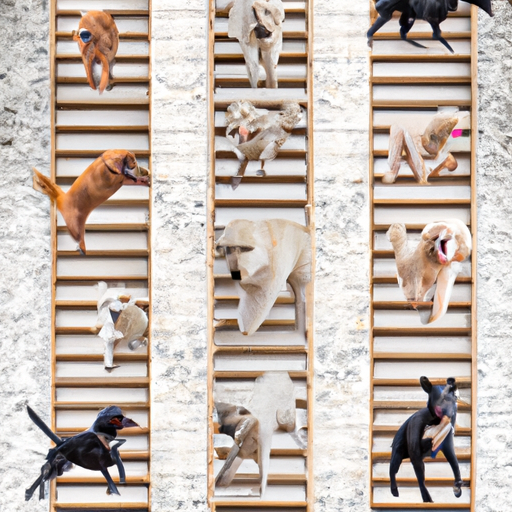If you’re a dog lover, you’ve probably noticed that not all dogs navigate the stairs in the same way. From the tentative approaches of small puppies to the confident strides of mature breeds, each dog has its own unique method. But what causes these differences? And how can you help your furry friend safely navigate those daunting steps? Let’s delve into this fascinating topic.
Table of Contents
- Factors Influencing How Dogs Go Down the Stairs
- Different Breeds, Different Approaches
- Helping Your Dog Navigate The Stairs Safely
- Anatomy And Stair Navigation
- Frequently Asked Questions
Key Takeaways
- Different dog breeds navigate stairs differently due to a combination of factors including size, breed, age, health and training.
- Larger breeds tend to descend stairs more easily than smaller breeds.
- Training and patience are crucial in helping your dog navigate stairs.
- Regular vet check-ups can help ensure your dog’s health doesn’t affect their stair navigation.
Factors Influencing How Dogs Go Down the Stairs
Size Matters
The size of your dog can significantly impact how they tackle stairs. Larger breeds like the Labrador Retriever or the German Shepherd have longer legs, enabling them to descend stairs more easily than their smaller counterparts. Smaller breeds, like the Chihuahua or Dachshund, might find stairs more challenging due to their shorter legs and smaller stride.
Age and Health
A dog’s age and health status can also influence how they navigate stairs. Young puppies and older dogs may struggle more with stairs due to their developmental stage or health conditions such as arthritis. Regular vet check-ups can ensure that your dog’s health doesn’t affect their ability to navigate stairs.
Different Breeds, Different Approaches
Different dog breeds have different body structures, which can dictate their approach to stairs. For instance, breeds with longer bodies like Dachshunds or Corgis may find stairs more challenging due to their unique body shape. On the other hand, agile breeds like Border Collies or Australian Shepherds may navigate stairs with relative ease.
If you’re interested in learning more about the characteristics of different dog breeds, OneTopDog provides valuable insights. For instance, this post offers an overview of various breeds and their unique traits, while this article delves into how specific breeds interact with stairs.
Helping Your Dog Navigate The Stairs Safely
It’s essential to ensure your dog’s safety when navigating stairs. Here are some tips:
- Training: Start training your dog to use the stairs from a young age. Use treats and positive reinforcement to encourage them.
- Patience: Don’t rush the process. Allow your dog to take its time to get comfortable with stairs.
- Support: For smaller or older dogs, consider using a doggy ramp or stairlift.
Anatomy And Stair Navigation
The anatomy of a dog plays a significant role in stair navigation. For instance, breeds with short snouts, like Bulldogs or Pugs, may find stairs challenging due to their brachycephalic nature, which can cause breathing issues.
The Canine Health Foundation provides an excellent resource on understanding the challenges faced by these breeds.
Frequently Asked Questions
Why does my dog refuse to go down the stairs?
Fear, pain, or discomfort could be reasons why your dog refuses to navigate stairs. It’s essential to consult with a vet to rule out any potential health issues.
How can I help my dog overcome its fear of stairs?
Positive reinforcement, patience, and gradual exposure can help your dog overcome its fear of stairs. If the fear persists, consider seeking advice from a professional dog trainer.
Are stairs bad for dogs?
Stairs are generally safe for dogs. However, dogs prone to joint issues, like Dachshunds or Bulldogs, or elderly dogs may face difficulties. It’s recommended to consult with a vet for advice tailored to your dog’s specific needs.
In conclusion, understanding how different dogs navigate stairs can help you better cater to your pet’s needs, ensuring their safety and comfort. Whether you’re helping a new puppy become accustomed to stairs or aiding an older dog, patience, understanding, and knowledge are key. Remember, every dog is unique – what works for one might not work for another. Keep exploring, keep learning, and you’ll help your furry friend master the stairs in no time. If you’re looking for further tips on dog care, check out this helpful resource.



